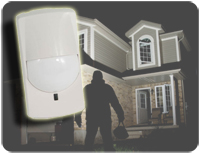
Microwave Motion Sensor: How Microwave Detectors Work & When to Use

Microwave motions sensors are very often the choice of homeowners and business owners when it comes to protecting their property against intruders. Protecting your home or business is important, especially if you are located in an area that is prone to crime. Motion sensors are affordable and offer added protection over door and window alarms. Motion sensors are able to detect when there is any movement within a designated area. When movement is detected, your alarm will be triggered to go off. Very often just your alarm going off will be enough to scare intruders away.
How Microwave Motion Detectors Work
Microwave sensors work by emitting a microwave beam over a designated area. When the beams are invaded by motion your alarm will sound. Microwave sensors are most often used in homes and businesses when no one is on the premises. Businesses use them when they close for the evening and many homeowners use them for when they are at work during the day or away from their home for an extended period of time, like a vacation.
Microwave motion detectors come in two varieties to protect your property. You can choose between having your sensor contained in one unit, otherwise known as a monostatic or to have it contained in two unites known as bistatic. Monostatic units are smaller but have a bit more flexibility in covering specific areas. They can cover approximately 400 linear feet and the area can be configured just about any way you want it to be, whether equal length and width or stretched out to be long and narrow.
Bistatic microwave detectors are able to cover more area up to as much as 1500 linear feet. At the same time however, it is much harder to define the area that bistatic units cover. Bistatic sensors also tend to have more false alarms.
Things You Need To Be Aware Of
Microwave sensors do have some issues that you will want to be aware of before installing.
- The sensors cannot penetrate metal. Therefore, if there is metal in the sensor field anything behind it may not be detected. This can cause dead zones in those areas. Savvy thieves that know you have a microwave sensor may be able to bypass your alarm by using metal and moving slowly.
- The sensors are very sensitive and are often known for giving off false alarms. Microwave sensors can provide great protection and in fact sometimes too great. The sensors are able to penetrate through walls so if it is a breezy day it may detect even grass moving in the wind and set off the alarm.
- It is often recommended using another type of sensor in conjunction with microwave motions sensors in order to receive the best protection. Infrared sensors are often recommended to help cover the dead zones often found in microwave sensor areas.
Microwave sensors are a great way to protect your home or your business. They are fairly inexpensive and easy to install. You will have maximum protection for your property when you use microwave sensors in conjunction with other infrared sensors, door and window alarms, video surveillance, etc.
Related Security Product Articles

Outdoor motion sensors are a great way to make your home more secure and conserve energy. Understand the different types, components, and how they work.

Are you worried your pets will set of your alarm? There are pet friendly motion sensors that allow your pets roam your home without triggering a false alarm.

Details on various components that go into a home security system. See what products are right for your alarm system and understand the products available.

